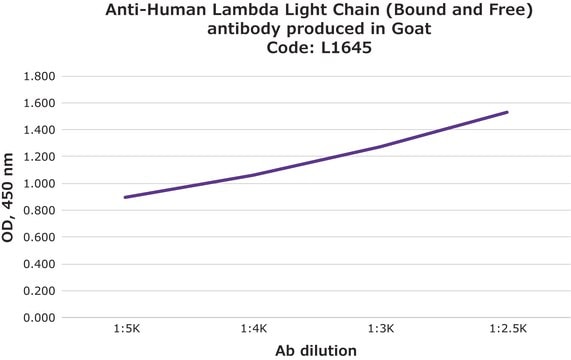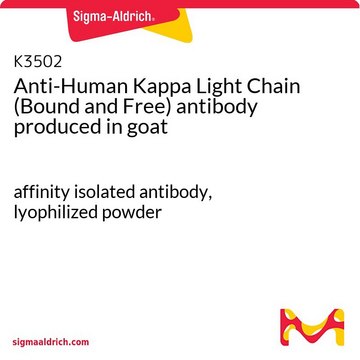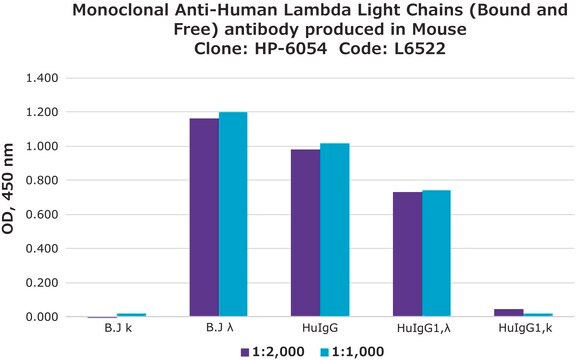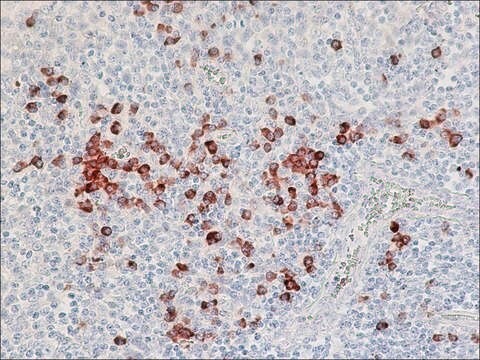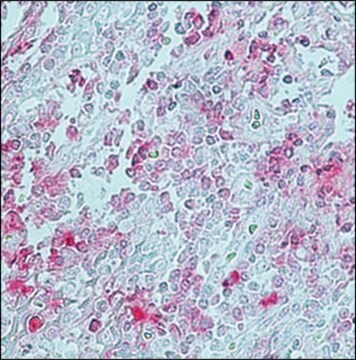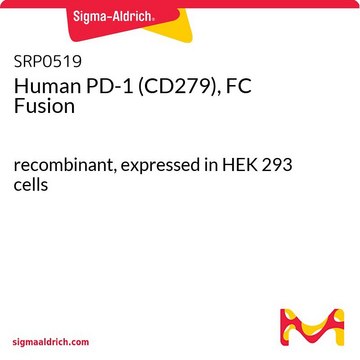K4377
Monoclonal Anti-Human Kappa Light Chain (Bound and Free) antibody produced in mouse
clone KP-53, ascites fluid
Synonym(s):
Monoclonal Anti-Human Kappa Light Chain (Bound and Free)
Sign Into View Organizational & Contract Pricing
All Photos(1)
About This Item
Recommended Products
biological source
mouse
Quality Level
conjugate
unconjugated
antibody form
ascites fluid
antibody product type
secondary antibodies
clone
KP-53, monoclonal
contains
15 mM sodium azide
technique(s)
indirect ELISA: 1:10,000
isotype
IgG1
shipped in
dry ice
storage temp.
−20°C
target post-translational modification
unmodified
Looking for similar products? Visit Product Comparison Guide
General description
Monoclonal Anti-Human Kappa Light Chain (mouse IgG1 isotype) is derived from the hybridoma produced by the fusion of mouse myeloma cells and splenocytes from an immunized mouse. Immunoglobulins G are made up of two identical light chains and two identical heavy chains, that are covalently connected by interchain disulphide bonds. Genes of kappa and lambda constant region are mapped on to human chromosome 2.
Specificity
The antibody is specific for human kappa (κ) light chains. This antibody is reactive with intact IgG (κ), IgM (κ), free kappa light chains, and Bence-Jones kappa light chains. It is non-reactive with lambda light chains.
Application
Monoclonal Anti-Human Kappa Light Chain (Bound and Free) antibody produced in mouse has been used for:
- immunodetection
- in western blot analysis
- in intracellular kappa light chain staining for flow cytometric analysis
Physical form
Monoclonal Anti-Human Kappa Light Chain (Bound and Free) antibody produced in mouse is provided as ascites fluid with 0.1% sodium azide (see MSDS) as a preservative.
Storage and Stability
For continuous use, store at 2-8 °C. For extendedstorage, the solution may be frozen in working aliquots. Repeated freezing and thawing is not recommended. Storage in "frost-free" freezers is not recommended. If slight turbidity occurs upon prolonged storage, clarify the solution by centrifugation before use.
Disclaimer
Unless otherwise stated in our catalog or other company documentation accompanying the product(s), our products are intended for research use only and are not to be used for any other purpose, which includes but is not limited to, unauthorized commercial uses, in vitro diagnostic uses, ex vivo or in vivo therapeutic uses or any type of consumption or application to humans or animals.
Not finding the right product?
Try our Product Selector Tool.
Storage Class Code
10 - Combustible liquids
WGK
nwg
Flash Point(F)
Not applicable
Flash Point(C)
Not applicable
Choose from one of the most recent versions:
Already Own This Product?
Find documentation for the products that you have recently purchased in the Document Library.
Customers Also Viewed
Visualisation of intracellular production bottlenecks in suspension-adapted CHO cells producing complex biopharmaceuticals using fluorescence microscopy
Mathias S, et al.
Journal of Biotechnology, 271, 47-55 (2018)
Upregulated expression of kappa light chain by Epstein-Barr virus encoded latent membrane protein 1 in nasopharyngeal carcinoma cells via NF-kappaB and AP-1 pathways
Liu H, et al.
Cellular Signalling, 19(2), 419-427 (2007)
Chloe L Stoyle et al.
The Biochemical journal, 474(18), 3179-3188 (2017-08-09)
Rodent monoclonal antibodies with specificity towards important biological targets are developed for therapeutic use by a process of humanisation. This process involves the creation of molecules, which retain the specificity of the rodent antibody but contain predominantly human coding sequence.
Heterogeneity of aberrant immunoglobulin expression in cancer cells
Hu D, et al.
Cellular & Molecular Immunology, 8(6), 479-479 (2011)
Expression and secretion of immunoglobulin alpha heavy chain with diverse VDJ recombinations by human epithelial cancer cells
Zheng H, et al.
Molecular Immunology, 44(9), 2221-2227 (2007)
Our team of scientists has experience in all areas of research including Life Science, Material Science, Chemical Synthesis, Chromatography, Analytical and many others.
Contact Technical Service